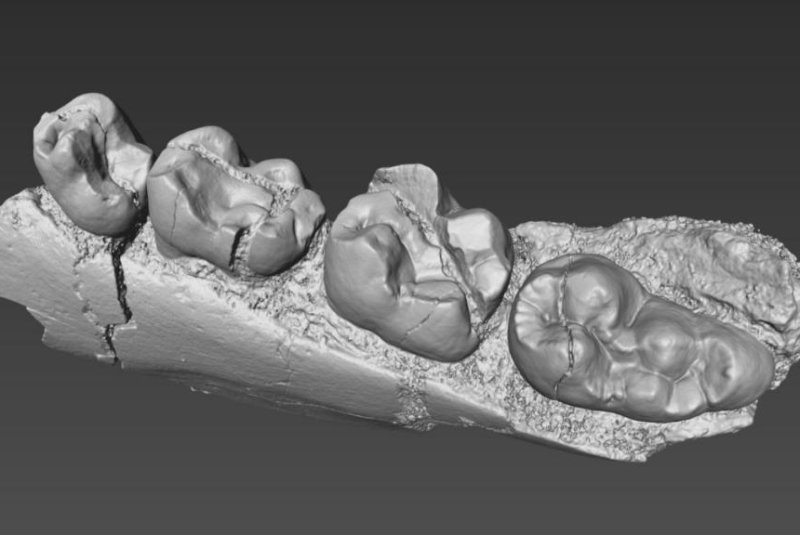The primitive nature of the 22-million-year-old teeth suggest the species they belonged to, Alophia metios, ate primarily hard fruits, seeds and nuts. Photo by the University of Texas at Austin
March 12 (UPI) -- Ancient fossilized teeth discovered in Kenya have helped paleontologists fill a gap in the record of Old World monkey evolution.
The 22-million-year-old teeth belonged to a newly named monkey species, Alophia metios. The discovery bridged the gap between a 19-million-year-old fossil tooth found in Uganda and a 25-million-year-old fossil tooth recovered in Tanzania.
"For a group as highly successful as the monkeys of Africa and Asia, it would seem that scientists would have already figured out their evolutionary history," John Kappelman, an anthropology and geology professor at the University of Texas at Austin, said in a news release. "Although the isolated tooth from Tanzania is important for documenting the earliest occurrence of monkeys, the next 6 million years of the group's existence are one big blank. This new monkey importantly reveals what happened during the group's later evolution."
Kappelman and his colleagues found the ancient teeth in West Turkana, an arid region of Kenya that was once wet and lush, home to forests, rivers and streams.
Scientists uncovered hundreds of fossils in the effort to uncover the story of early monkey evolution, including mammal and reptile jaws, limbs and teeth dating from 21 million to 24 million years old. They also found monkey teeth.
Interestingly, the 22-million-year-old teeth lacked the pair of molar crests, known as "lophs," found among the teeth of geologically younger monkeys.
"These teeth are so primitive that when we first showed them to other scientists, they told us, 'Oh no, that isn't a monkey. It's a pig,'" said Ellen Miller, an anthropology professor at Wake Forest University. "But because of other dental features, we are able to convince them that yes, it is in fact a monkey."
The molars of modern-day monkeys are incredible versatile, capable of breaking down a wide variety of foods and allowing monkeys to adapt to range of habitats.
"How and when this unique dentition evolved is one of the unanswered questions in primate evolution," said James Rossie, an anthropology professor at Stony Brook University.
Researchers estimated the newly discovered species -- described in the journal PNAS -- used its primitive monkey teeth to mostly process hard fruits, seeds and nuts, no leaves. More versatile molars were adopted by later monkey species.
"It is usually assumed that the trait responsible for a group's success evolved when the group originated, but Alophia shows us this is not the case for Old World monkeys," said Samuel Muteti, a researcher at the National Museums of Kenya. "Instead, the characteristic dentition of modern monkeys evolved long after the group first appeared."
Africa and Arabia were once joined as an island continent, and collided with Eurasia between 20 and 24 million years ago. Some researchers hypothesize the arrival of new species in Africa in the wake of the collision -- antelope, pigs, lions and rhinos -- pushed Old World monkeys to begin exploiting leaves, triggering the evolution of versatile detention.
It's also possible, some scientists hypothesize, climate change made leaves a more attractive and reliable food source.
"The way to test between these hypotheses is to collect more fossils," Kappelman said. "Establishing when, exactly, the Eurasian fauna entered Afro-Arabia remains one of the most important questions in paleontology, and West Turkana is one of the only places we know of to find that answer."















